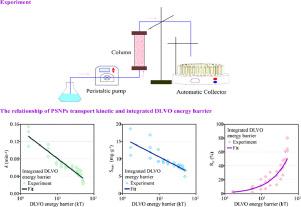Water Research ( IF 12.8 ) Pub Date : 2022-08-13 , DOI: 10.1016/j.watres.2022.118978 Xinyao Ye 1 , Zhou Cheng 2 , Ming Wu 3 , Yanru Hao 1 , Guoping Lu 1 , Bill X Hu 4 , Cehui Mo 1 , Qusheng Li 5 , Jianfeng Wu 6 , Jichun Wu 6

|
Microplastics are widely detected in the soil-groundwater environment, which has attracted more and more attention. Clay mineral is an important component of the porous media contained in aquifers. The transport experiments of polystyrene nanoparticles (PSNPs) in quartz sand (QS) mixed with three kinds of clay minerals are conducted to investigate the effects of kaolinite (KL), montmorillonite (MT) and illite (IL) on the mobility of PSNPs in groundwater. Two-dimensional (2D) distributions of DLVO interaction energy are calculated to quantify the interactions between PSNPs and three kinds of clay minerals. The critical ionic strengths (CIS) of PSNPs-KL, PSNPs-MT and PSNPs-IL are 17.0 mM, 19.3 mM and 21.0 mM, respectively. Experimental results suggest KL has the strongest inhibition effect on the mobility of PSNPs, followed by MT and IL. Simultaneously, the change of ionic strength can alter the surface charge of PSNPs and clay minerals, thus affecting the interaction energy. Experimental and model results indicate both the deposition rate coefficient (k) and maximum deposition (Smax) linearly decrease with the logarithm of the DLVO energy barrier, while the mass recovery rate of PSNPs (Rm) exponentially increases with the logarithm of the DLVO energy barrier. Therefore, the mobility and associated kinetic parameters of PSNPs in complex porous media containing clay minerals can be predicted by 2D distributions of DLVO interaction energy. These findings could help to gain insight into understanding the environmental behavior and transport mechanism of microplastics in the multicomponent porous media, and provide a scientific basis for the accurate simulation and prediction of microplastic contamination in the groundwater system.
中文翻译:

粘土矿物对聚苯乙烯纳米塑料在地下水中迁移的影响
微塑料广泛存在于土壤-地下水环境中,引起了越来越多的关注。粘土矿物是含水层所含多孔介质的重要组成部分。进行了聚苯乙烯纳米粒子(PSNPs)在石英砂(QS)中与三种粘土矿物混合的输运实验,研究了高岭石(KL)、蒙脱石(MT)和伊利石(IL)对PSNPs在地下水中迁移率的影响。 . 计算 DLVO 相互作用能的二维 (2D) 分布以量化 PSNP 与三种粘土矿物之间的相互作用。PSNPs-KL、PSNPs-MT 和 PSNPs-IL 的临界离子强度 (CIS) 分别为 17.0 mM、19.3 mM 和 21.0 mM。实验结果表明,KL对PSNPs迁移率的抑制作用最强,其次是MT和IL。同时,离子强度的变化可以改变PSNPs和粘土矿物的表面电荷,从而影响相互作用能。实验和模型结果表明沉积速率系数(k ) 和最大沉积量 ( S max ) 随 DLVO 能垒的对数线性减小,而 PSNPs 的质量恢复率 (R m ) 随 DLVO 能垒的对数呈指数增长。因此,PSNPs 在含有粘土矿物的复杂多孔介质中的迁移率和相关动力学参数可以通过 DLVO 相互作用能的二维分布来预测。这些发现有助于深入了解微塑料在多组分多孔介质中的环境行为和迁移机制,为准确模拟和预测地下水系统中的微塑料污染提供科学依据。



























 京公网安备 11010802027423号
京公网安备 11010802027423号